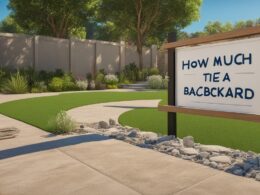Are you considering stump grinding but unsure about the cost? Understanding the factors that influence stump grinding prices can help you budget effectively and make an informed decision. In this guide, we’ll explore the cost of stump grinding, pricing factors, and tips to save money.
When it comes to stump grinding, the average price typically ranges from $158 to $450, with most homeowners paying around $313. However, several factors can affect the cost of your stump grinding project.
The size of the stump is one of the primary pricing factors. On average, you can expect to pay between $2 and $3.50 per inch. The type of stump also plays a role, with harder woods potentially costing more to grind.
Additionally, the number of stumps, completion time, terrain challenges, and debris removal can influence the overall cost. Discounts may be available for multiple stumps, but difficult terrain or extensive debris removal can add to the expense.
While some homeowners opt for a DIY approach to save money, it’s essential to consider the potential challenges and costs involved. Renting a stump grinder and safety gear can cost between $445 and $585 on average.
It’s worth noting that stump grinding costs can vary based on your location and local market conditions. Urban areas typically have higher costs due to the increased cost of living, while factors like soil condition and tree density can impact prices in specific regions.
To save money on stump grinding, consider obtaining multiple quotes from professional services and comparing them. Additionally, bundling stump grinding with related services such as tree removal or tree trimming can often result in cost savings.
Whether you choose to hire a professional or tackle stump grinding yourself, it’s crucial to prioritize safety and wear the appropriate protective equipment.
Stay tuned for the rest of our guide as we delve into the factors affecting stump grinding cost, explore related services and costs, discuss DIY stump grinding, and provide helpful tips to ensure you get the best value for your money.
Factors Affecting Stump Grinding Cost
When it comes to the cost of stump grinding, several factors can influence the final price. Understanding these factors can help you estimate the expenses involved in your stump grinding project. Here are the key factors that affect the cost:
Stump Size
The size of the stump often plays a significant role in determining the cost. Stump grinders typically charge an average rate of $2 to $3.50 per inch of stump diameter. Larger stumps will require more time and effort to grind, resulting in higher costs.
Stump Type
The type of wood in the stump can also impact the price. Harder woods, such as oak or maple, are generally more difficult to grind compared to softer woods like pine. Grinding harder woods requires more specialized equipment and can drive up the cost.
Quantity
If you have multiple stumps that need grinding, some stump grinders may offer discounted rates for additional stumps. The more stumps you have, the more bargaining power you may have to negotiate a lower overall cost.
Completion Time
The time it takes to complete the stump grinding project can also affect the cost. If there are delays in the process due to factors like stump location, accessibility, or soil conditions, the overall cost may increase. It’s important to factor in any potential delays when estimating the total expenses.
Terrain
The terrain where the stumps are located can impact both the difficulty and cost of the job. Challenging terrain, such as rocky areas or steep inclines, can make it more challenging for stump grinders to access the stumps and perform the grinding. As a result, the cost may be higher to account for the added effort and potential equipment requirements.
Debris Removal
Debris removal is typically an additional cost in stump grinding projects. Stump grinders may charge rates ranging from $2 to $4 per inch of stump diameter or a flat fee for debris removal. It’s important to clarify the debris removal costs with your chosen stump grinding service provider.
Understanding these factors can give you a better idea of the various elements that contribute to the cost of stump grinding. It’s essential to consider these factors and gather quotes from multiple stump grinding services to ensure you get the best value for your money.
Other Related Services and Costs
Stump grinding may be combined with other related services, providing cost savings and convenience. When removing a stump, it is common to require additional services such as root removal, tree removal, tree trimming, tree transplanting, or sodding to complete the project efficiently.
Root Removal
Root removal is often necessary when dealing with stubborn stumps. It involves extracting the root system from the ground, preventing regrowth and potential damage to nearby structures. The average cost for professional root removal ranges from $118 to $175 per hour, depending on the complexity of the job.
Tree Removal
If the stump is part of a larger tree removal project, you can expect additional costs. The average cost for tree removal ranges from $385 to $1,070, with larger and more complex projects reaching closer to $2,000. Factors such as tree size, accessibility, and the presence of obstacles can influence the final price.
Tree Trimming
When dealing with overgrown trees, tree trimming is often necessary before or after stump grinding. Tree trimming involves pruning branches to ensure the tree’s health and safety. The average cost for professional tree trimming ranges from $315 to $700, depending on the size and complexity of the tree.
Tree Transplanting
Tree transplanting is an option if you wish to relocate a tree rather than removing it altogether. The cost of tree transplanting can range from $175 to $800 or more, depending on the size and type of the tree. It is essential to consult with a professional arborist to evaluate the feasibility of transplanting and ensure the tree’s successful relocation.
Sodding
After stump grinding, it is common to want to restore the area with fresh sod. Sodding involves laying down pre-grown grass to create a green and even surface. The cost of sodding typically ranges from $0.90 to $1.80 per square foot, depending on the type of sod and the size of the area.
DIY Stump Grinding Cost
If you have multiple stumps to grind, DIY stump grinding can be a cost-effective option. To get started, you’ll need to rent a stump grinder or consider buying one for future use.
Rental Cost: Renting a stump grinder typically costs $180 per day. This option is ideal if you have limited stumps to grind or prefer not to invest in a piece of equipment.
Buying a Stump Grinder: If you have numerous stumps on your property or anticipate the need for future grinding, purchasing a stump grinder may be a more practical choice. Prices for new stump grinders range from $1,730 to $3,370.
Safety Equipment: DIY stump grinding requires proper safety gear to protect yourself during the process. Essential safety equipment includes a chainsaw, work boots, chaps, shovel, hard hat, safety glasses, and hearing protection. The cost for these items can range from $445 to $585.
Remember, when conducting DIY stump grinding, it’s crucial to undergo proper training and operate the equipment safely to prevent accidents or injuries.
Location and Market Variations
When it comes to stump grinding rates, location and market variations can play a significant role in determining the cost. Different areas have different living costs, and this can translate into higher prices for stump grinding services in urban locations. So, if you’re living in a bustling city, be prepared for slightly steeper rates.
But that’s not all. Other factors, such as the soil composition and the type of hardwoods in your area, can also affect pricing. If your property has rocky soil or dense hardwoods that are more challenging to grind, it can lead to higher costs. Additionally, difficult access to the stump location, like steep inclines or tight spaces, may also impact the overall price.
If you happen to be located more than 50 miles away from a tree care company, don’t forget that travel fees might be applied. These fees are incorporated to cover the additional costs associated with traveling a longer distance.
In some cases, permits may be required to perform stump grinding, especially if you’re planning to grind stumps on public land. The costs of obtaining permits can range from $60 to $320, depending on your location and local regulations.
Considering all these location and market variations is crucial when budgeting for stump grinding. To get the most accurate estimate, it’s recommended to reach out to local tree care companies and obtain quotes tailored to your specific area.
What Factors Contribute to the Cost of Stump Grinding?
When understanding fire pit cost factors, it’s important to consider the size and location of the stump. Larger stumps require more time and labor to grind, while stumps in hard-to-reach areas may increase the cost. The type of tree and its root system also affect the difficulty and cost of stump grinding.
Conclusion
When considering stump grinding, it’s crucial to understand the various factors that can affect the cost. Stump size, type, quantity, completion time, terrain, and debris removal all play a role in determining the final price. By hiring a professional, you can benefit from their experience and equipment, which may prove to be more cost-effective in certain scenarios.
However, if you have multiple stumps to grind, opting for a DIY approach can help you save money. Renting a stump grinder and obtaining the necessary safety gear may be a more budget-friendly option in such cases. It is important to note that DIY stump grinding requires proper training and safety precautions to avoid accidents.
To ensure you get the best value for your money, always compare multiple quotes from reputable stump grinding services. Additionally, consider other related services, such as root removal, tree trimming, or sodding, that can be combined to potentially save on overall costs.
Whether you choose to hire a professional or take on the task yourself, always prioritize safety and factor in equipment costs when making your decision. With the right approach and careful consideration, you can effectively manage stump grinding expenses while achieving your desired results.










